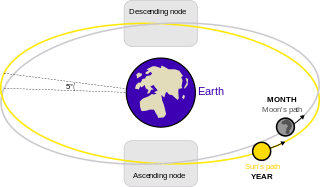Lunar node

The lunar nodes are the orbital nodes of the Moon, that is, the points where the orbit of the Moon crosses the ecliptic. The ascending or north node is where the moon crosses from south of the ecliptic to north of the ecliptic. The descending or south node is where it crosses from north of the ecliptic to south of the ecliptic.
Eclipses occur only near the lunar nodes: Solar eclipses occur when the passage of the Moon through a node coincides with the new moon; lunar eclipses occur when passage coincides with the full moon. A lunar eclipse may occur if there is a full moon within 11° 38' (Celestial Longitude), of a node, and a solar eclipse may occur if there is a new moon within 17° 25' of a node.
The plane of the lunar orbit precesses in space and hence the lunar nodes precess around the ecliptic, completing a revolution (called a draconic or nodal period) in 6798.3835 days or 18.612958 years (note that this is not the same length as a saros). The same cycle, measured against an inertial frame of reference such as ICRS (relative to the stars) is 18.599525 years.
The two solar eclipses in July 2000 (Solar eclipse of July 1, 2000 and Solar eclipse of July 31, 2000) were around the time that the moon was at its ascending node. Ascending-node eclipses recur after one draconic year on average, which is about 0.94901 Gregorian years, and the same goes for descending-node eclipses.
Names and symbols

.f18.jpg)
The nodes are called by different names in different areas of the world.
Since the ascending node is the point of intersection between the ecliptic and the plane of the lunar orbit where the Moon is ascending from the South to the North, it is sometimes called the North node. In ancient European texts, it is referred to as the dragon's head (Caput Draconis, or Anabibazon). The symbol of the ascending node is ![]() , the astronomical and astrological symbol for the Dragon's head. Similarly the descending node is the point where the Moon is descending from the North hemisphere to South hemisphere, and is sometimes referred to as South node. It is also known as the dragon's tail (Cauda Draconis, or Catabibazon), and its symbol is the inversion of that of the ascending node:
, the astronomical and astrological symbol for the Dragon's head. Similarly the descending node is the point where the Moon is descending from the North hemisphere to South hemisphere, and is sometimes referred to as South node. It is also known as the dragon's tail (Cauda Draconis, or Catabibazon), and its symbol is the inversion of that of the ascending node: ![]() . Note that the so-called North node may in fact lie South of the South node in the course of the nodal cycle.
. Note that the so-called North node may in fact lie South of the South node in the course of the nodal cycle.
In Hindu astronomy, the ascending node ☊ is called Rahu and the descending node ☋ is called Ketu. In Tibetan Astrology (partially based on the Kalachakra Tantra) the southern node is named Kalagni.
Extreme declinations
The lunar orbit is inclined by about 5.1 degrees to the ecliptic: hence the Moon can be up to about 5 degrees north or south of the ecliptic. The ecliptic is inclined by about 23.4° to the celestial equator, the plane that is perpendicular to the rotational axis of the Earth. As a consequence, once during the 18.6-year nodal period, when the ascending node of the Moon's orbit coincides with the vernal equinox, then the Moon reaches extreme northern and southern declinations. Then it also has its extreme northern and southern azimuth points of rising and setting on the horizon; its extreme lowest and highest altitude when crossing the meridian; and potentially extreme late first sightings of the new moon. Furthermore, occultations by the Moon of the star group the Pleiades, which are over 4° North of the ecliptic, occur during a comparatively brief period once every nodal period.
Astrological significance
In Western astrology the ascending and descending nodes are respectively known as the "North Node" and the "South Node". [1] Only the north node is usually marked in horoscopes, as the south node is by definition at the opposite point in the chart.
In Vedic astrology, the north and south nodes are called Rahu and Ketu respectively, and both are marked in the chart.
See also
References
- ↑ "The Lunar Nodes in signs - The urge to spiritually evolve". Retrieved 2016-08-26.
External links
- Sun and Moon Polar Applet, showing moonrise/moonset azimuths
- Astronomy Answers: What are the standstills of the Moon? Retrieved 2016-08-26.
- Eclipses, Cosmic Clockwork of the Ancients
- Lunar and solar periods, about inertial frame of reference for measuring movements of celestial bodies.
- Mean lunar and solar periods